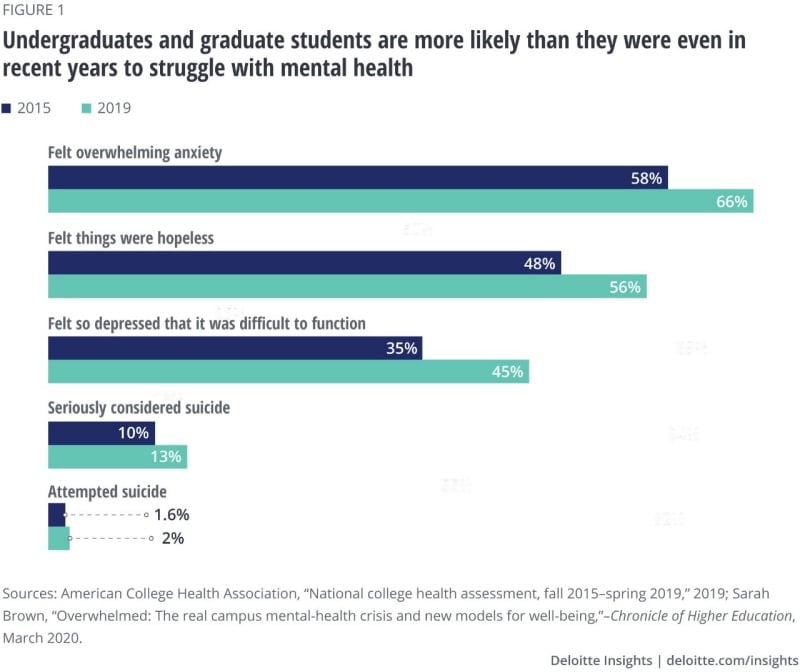Data plays an important role in identifying problems and building connections
By capturing population-level data across the entire institution, universities can unlock new insights and better direct resources for initiatives and policy changes. To do this, institutions must break down silos and set up a robust data analytics and governance strategy.
Oklahoma State, for example, has developed a robust data model using campuswide data paired with publicly available data sets to help measure student outcomes. This integrated data set has enabled university leadership to track engagement of students across the institution and identify which students may be most at risk. For Oklahoma State, the data revealed engagement to be a critical variable in student mental health. Using this knowledge, the school’s chief wellness officer now regularly collaborates with the student affairs office to drive engagement and build a sense of belonging and connectedness among students. Oklahoma State’s model also integrates data from the American College Health Association–National College Health Assessment (ACHA-NCHA) to connect each health variable to student retention, GPA, and engagement. This allows the school to better quantify the impact of its efforts—both for individual students, various student communities, and the student population as a whole.18
Looking to the future, universities should go beyond traditional participation metrics and shift the focus to outcomes. According to Duke’s Szigethy, metrics have been limited to how many people participated in a program and whether they liked it. By measuring outcomes such as resilience, self‐control, and self‐compassion, he says, institutions can better understand a program’s true impact.19 This will be a difficult step for many institutions as the data to measure outcomes is more difficult to obtain.
How you use technology can be critical
In some cases, technology can exacerbate feelings of social isolation and generate privacy concerns. According to Arizona State’s chief well‐being officer, Dr. Teri Pipe, technology is not a panacea. “To really shape programming and shape dialogue, [services need] to be based on what the individual needs,” she says. “We should use technology and automation, but not become over‐reliant on it.” Dr. Aaron Krasnow, associate vice president for Health and Counseling Services at Arizona State, agrees, citing a lack of human connection at the center of the majority of well‐being issues: “The role of technology as an enabler is important, but not at the expense of creating more isolation.”20 Meanwhile, Ohio State’s Melnyk stresses the importance of providing students with a menu of options, rather than relying solely on technology: “A lot of students will start these [remote] programs, but then they fade away, they don’t finish them.” She says that it is important to strike a balance; her team is currently undertaking a comparative study to better understand which approaches are most effective at driving desired outcomes.
Universities’ growing use of technology also poses privacy concerns. The way data is stored and collected, students’ ability to opt out, and the implications of a potential data breach are all crucial considerations. However, when used responsibly, technological tools can play a critical role in bringing new capabilities to campus communities, as noted above.
Activating the whole campus community
Long gone are the days when issues of physical or mental health and wellness were considered the sole responsibility of the campus health center. By making mental health an institutional priority, campus leaders signal a commitment to care that can create change. Everyone on campus—from administration to teaching faculty to support staff to students—can play a role in fostering this well‐being.
One way to formalize this commitment is to elevate the well-being leadership position on campus. In 2011, the Ohio State University was one of the first institution to move wellness to the C‐suite, with the creation of the chief wellness officer position. Other schools followed suit, including Arizona State University in 2016, creating a similar role at their campus.21
But such positions do little good without influence or infrastructure. Some positions lack a strong voice at senior decision‐making levels. By elevating these officers and providing a seat at the table, universities can begin to organically incorporate health, wellness, and maybe even well‐being into everything they do.
However, the onus is not only on the president’s cabinet. According to Oklahoma State University’s Chief Wellness Officer Dr. Todd Misener, “Well‐being leaders need to be at the forefront of lobbying for change.” One strategy is for leaders to tailor their messages to financially minded stakeholders. In many cases, a single percentage‐point increase in student retention—brought on by more robust initiatives, with policy and environmental change—can lead to a more reliable revenue stream from tuition that results from retaining and educating more students.22
This work requires a settings approach and systems thinking; it is important that the full campus community is involved. “For me, wellness requires a supportive culture,” says Misener. “It's not one person's job, and it's not my job to be all things wellness to everyone. My job is to advocate for a healthy environment for students, faculty, and staff, and their families.”23 Arizona State University’s Pipe also emphasized collaboration, indicating that it is essential to bring together people with similar roles and incorporate their ideas, adopting cohesive and personalized efforts, rather than a “command‐and‐control” approach.24
Johns Hopkins University has similarly embraced holistic governance at their institution. The university’s Office of Student Health & Well‐Being serves as a coordinating hub for efforts across campus, driving alignment across departments, crafting and operationalizing strategy, and assessing successes and opportunities for continuous improvement.25

















